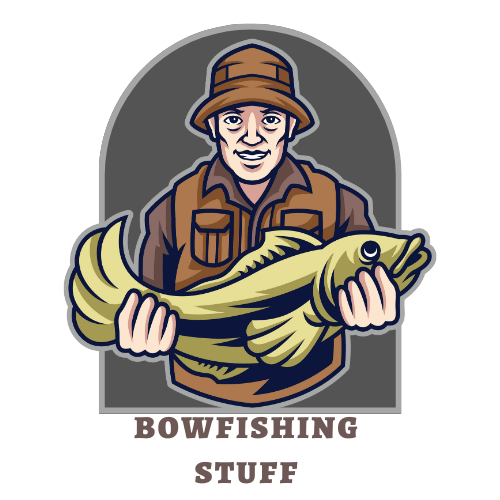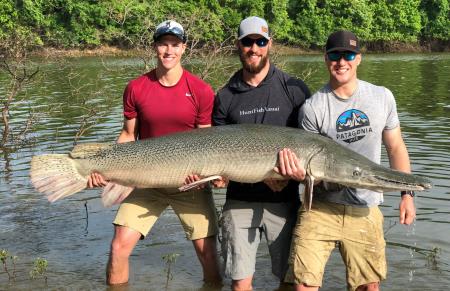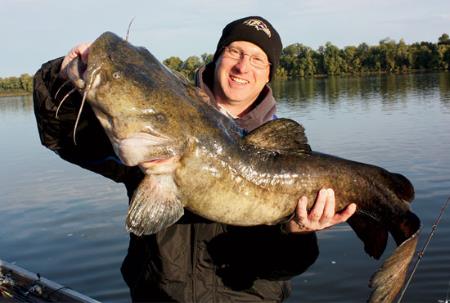Take a few minutes to educate yourself about many of the different bowfishing species of rough fish swimming around the lakes & rivers of this great country.
By becoming more familiar with each species’ traits, you will understand why bowfishing plays an important role in good conservation.
Bowfishing Species Legal to Harvest with Bow & Arrow
Bowfin (Grinnell)

The bowfin is the only living representative of an ancient family of fishes. It has an air-bladder that functions somewhat like a lung, and they are often seen near the surface of the water gulping mouthfuls of air.
Identification: They are easily recognized by its flattened head; long, stout body; large mouth full of small, sharp teeth; a long dorsal fin that extends along most of the back; and rounded tail.
The pelvic fins are set far back on the belly near the middle of the body and the pectoral fins are low on the sides so that the overall appearance is one of three sets of fins in a row; the pectorals behind the head, the pelvis near the midbody, and the anal fin near the tail.
Also, two short tube-like barbells are located near the nostrils. The body is olive-green above, shading to pale yellow or cream on the belly. Several dark brown, horizontal bars are often evident on the cheeks.
Males have a dark spot with a bright orange halo, on the upper part of the tail fin. The spot is absent or inconspicuous on females.
Fresh Water Drum

Common names : Freshwater drum, Sheephead, Grunter, Silver bass, Gray bass
Scientfic name: Aplodinotus grunniens
Identification: Freshwater drum are silver-gray in color with a mouth that points down, and a rounded tail. Skeletal features are unique, with the skull heavily reinforced and large ear bones, with a characteristic “L” on one side.
Range and habtat: The freshwater drum is native to Ohio. They inhabit deeper pools of rivers and prefer large lakes that are less than 60 feet deep.
Life history: Freshwater drum spawn from spring to late summer. Females broadcast eggs into water where they float on the surface and hatch in about one day and are left to survive on their own. Adults feed on mollusks, crayfish, fish, and aquatic insects.
Adult sieze: In Lake Erie, freshwater drum run less than 20 pounds. In rivers they can reach 40 pounds.
Fishing methods: Freshwater drum are frequently taken by anglers fishing for other species with both artificial and natural bait. This species is harvested commercially in Lake Erie.
Paddlefish

Description: Paddlefish, spoonfish, spoonbill cat, and Polyodan spathula are among several names given to this unique prehistoric fish. The paddlefish is the largest (over 200 pounds, six-feet long) freshwater fish in the United States and is found in 26 states that have large streams, rivers, and impoundments within the Mississippi River basin and adjacent Gulf Coastal drainages.
Small Mouth Buffalo

Description: Ictiobus and Bubalus are both Greek words meaning “bull fish” and “buffalo,” respectively.
Identification: The back and sides are light brown or otherwise dark with a coppery or greenish tent. The belly is a pale yellow to white.
Smallmouth buffalo scales are large, and the species sometimes be confused with common carp by the novice. However, buffalo lack the barbels of carp. Smallmouth buffalo, as opposed to bigmouth buffalo, have a distinctive sucker-type mouth, oriented downward.
Bigmouth Buffalo

Description: Non-native. Introduced in 1918.
Identification: Heavy bodied fish, back is gray to olive-bronze with green-copper reflections. Sides, black to olive-yellow; Belly, pale yellow to white. Head large and ovoid with a sharply oblique, terminal mouth. No barbels or spines.
Length: 12 to 41 inches.
Weight: 1 to over 39 pounds.
Shortnose gar

Description – They have irregular round, black spots on the top of the head and over the entire body and on all the fins. Other gars, except for spotted gars, have spots on the fins and usually on the posterior part of the body. They can be distinguished from other gars, such as spotted gars, by the distance from the front of the eye to the back of the gill cover.
Identification: In Florida gars, the distance is less than two-thirds the length of the snout. In spotted gars, the distance is more than two-thirds the length of the snout.
Other characteristics of Florida gars include a shorter, broader snout with a single row of irregularly spaced sharp teeth on both upper and lower jaws and no bony scales on the throat.
The coloration is olive-brown along the back and upper sides with a white-to-yellow belly. The young sometimes have dark stripes along back and sides.
Longnose Gar

Description – They are olive-brown or deep green along the back and upper sides, with silver-white bellies. There are a few irregular, large dark spots on the body.
The young display scattered spots over both sides, the upper and lower jaws and on their ventral fins. The longnose is generally distinguished from other gars by its longer, more slender body, and especially by its longer, narrower snout. The snout is twice the length of the rest of the head.
Spotted Gar

Description – Spotted gars are almost identical to Florida gars. Both species are the only two gars that have dark spots on the top of the head as well as over the entire body and on all the fins. They can be distinguished by the distance between the front of the eye and the rear edge of the gill cover.
If the distance is more than two-thirds the length of the snout, it is a spotted gar. If the distance is less than two-thirds the length of the snout, it is a Florida gar. Spotted gars have a single row of teeth in each jaw and has a much broader snout than that of the longnose gar. The coloration generally is darker than that of Florida gars, some fish being almost black, depending on the color of the water.
Alligator Gar
Identification – They are one of the most distinctive freshwater fish species. Alligator gars are the largest of all gar species with a head that looks very much like an alligator’s. They can be distinguished from all other gars species by the two rows of teeth in the upper jaw, their short-broader snout, and their size when fully grown.
The body is long, slender, and olive or greenish brown (sometimes black) along the back and upper sides with white to yellow bellies. The sides are mottled toward the head with large black spots toward the rear and on the rear fins. The young have a light stripe along their back from tip of snout to upper base of the caudal fin.
Shad Fish
Description: American shad are anadromous fish, meaning they spend most of their lives in saltwater but spawn in freshwater. Shad are found along the Atlantic seaboard from Labrador to Florida. Shad are an important food source for other fish such as bluefish and striped bass.
Rising spring temperatures prompt shad to leave the ocean and return to the waters in which they were born. Biologists believe the fish find their natal streams through their uncanny sense of smell. Males arrive on the spawning grounds first, followed by egg-laden females. A female releases 100,000 to 600,000 eggs into the water to be fertilized by several males. Adult shad return to the ocean soon after spawning.
The transparent fertilized eggs are carried along by the current. The larvae hatch in 4 to 12 days. Juvenile shad spend their first summer in freshwater. By autumn, the young shad gather in schools and swim to the ocean. They will live in the ocean from three to six years, until sexually mature then return to freshwater to complete their life cycle. This sustained a thriving shad population for centuries, but this changed as America prospered.
Channel Catfish
Description – Channel catfish closely resemble blue catfish. Both have deeply forked tails. However, channels have a rounded anal fin with 24-29 rays and scattered black spots along their back and sides. They have a small, narrow head. The back is blue-gray with light blue to silvery-gray sides and a white belly.
Larger channels lose the black spots and also take on a blue-black coloration on the back which shades to white on the belly. Males also become very dark during spawning season and develop a thickened pad on their heads.
Yellow Catfish

Description – The yellow bullhead closely resembles the brown bullhead with a squat body and a round or square tail. It is yellow-olive to slate-black above and lighter, often yellow to yellow-olive, on its sides with little to no mottling. The belly may be white, cream or yellow.
The chin barbels are yellow to buff or pale pink; the upper barbels, which are light to dark-brown, help distinguish this species from brown bullheads. The anal fin has a straight margin with 23 to 27 rays.
Blue Catfish
Description – Adult fish have stout bodies with prominently humped backs in front of the dorsal fin. They resemble channel catfish by having deeply forked tails, but are dissimilar because they are unspotted and have a long, straight-edged anal fin with 30 to 35 rays.
The back and upper sides are blue to slate gray, and the lower sides and belly are white. The internal air bladder has a constriction in the middle, giving it a two-chambered appearance.
Catfish (Flathead)
Description – A flattened head, tiny eyes, squarish tail, and protruding lower jaw distinguish the flathead from other catfish and contribute to it being placed in a genus of its own. They are yellow-brown and usually mottled above, with a creamy-white or yellow belly. Small flatheads may be confused with yellow or brown bullheads.
Goldfish

Although it is impossible to sex Goldfish when they are young and not in the breeding season, the male is usually smaller and more slender than the female. In the breeding season, the male has white prickles, called breeding tubercles, on its gill covers and head. Seen from above, the female will have a fatter appearance as she is carrying eggs.
Skipjack Herring
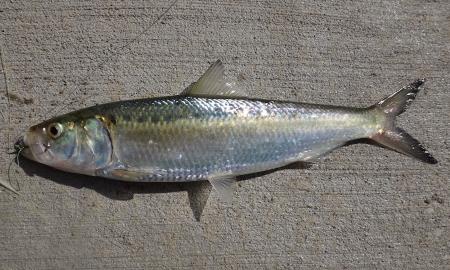
Description: A typical herring or shad it is silvery colored with a small dorsal fin, deeply forked caudal fin and small mouth. The lower jaw on a skipjack extends in front of the upper jaw and the fish is very compressed (flattened side to side). There is no dark marking on the shoulder.
Common Carp

Common carp is the main aquaculture species in many European and Asian countries. This fish has several advantages that made it so popular for commercial culture:
- Very fast growth rate
- High tolerance and easiness to handle
- Ability to be raised in high density and to give high production per square unit
- Ability to utilize prepared diet with relatively low content of protein, and
- Occurrence of highly productive strains and breeds reared during a long-term process of selection and domestication.
Five species of Asian carp now occur in the United States. The species most anglers are familiar with is the common carp Cyprinus carpio. Common carp, brought to the United States in 1831, were soon propagated and distributed throughout the country.
Common carp are so universally common today that they are generally considered part of the native fish community. However, few anglers would argue that our lakes and rivers would be better without them.
White Amur or Grass Carp

The grass carp, also known as the white amur, is a vegetarian fish native to the Amur River in Asia. Because this fish feeds on aquatic plants, it can be used as a biological tool to control nuisance aquatic plant growth.
Carp (High Fin Carpsucker)

Overall distribution: Along the Gulf Coast, these suckers range from Louisiana eastward to the Choctawhatchee River of Florida. In the west, it ranges northward from Louisiana to the Texas-Oklahoma border and north to Minnesota and Wisconsin. In the east it ranges from Florida, northward to North Carolina and Ohio.
Bighead Carp
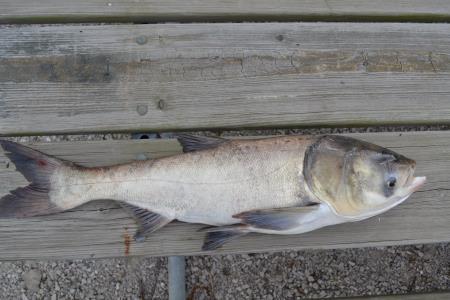
Where Did the Big Head Carp Come From?
The big head carp is native to Asia?
It was introduced to the Mississippi River when private hatchery ponds were washed out in the state of Arkansas in the 1970’s or possibly they were let go into the wild when they were no longer needed on by the fish farmers.
Appeared in open water in the early 1980’s in the Ohio and Mississippi Rivers?
Big head carp have been found in at least 19 states including Lake Erie.
Why are Big Head Carp a Problem?
- Big head carp eat blue green algae, zooplankton, and aquatic insects and larva.
- The big head carp does not have a true stomach so it must constantly eat.
- It is also thought that big head carp will compete for food with fish that are still in the larval stage and fish populations decrease because the larval fish do not get enough food to survive.
- The big head carp is also a very high jumper. They can jump high enough to strike boaters in their boats.
- Bighead carp spawn when the water temperature is between 77-86 degrees.
- Females spawn between April and June, with the peak spawning season in late May.
- Females carry 660,000-872,000 eggs on average.
- As female big head carp get older they increase the number of eggs they carry each time they spawn.
- Some cultures will but two of these fish live, one for eating, and one for release. This is not a safe practice; it will only help the populations grow.
What do Big Head Carp Look Like?
- Bid head carp are dark green to olive in color on their backs.
- They have gray to silvery sides, with a white to cream-colored belly.
- Scales are very tiny, and the eyes are set below the midline of the body.
- Body of a big head carp is long and compressed.
- Head is very large compared to the body, this is where the fish gets it’s name, the big head carp.
- They can weigh from 55-110 lbs (25-50 kg).
- Bighead carp can be up to 59 inches (1.5 meters) long.
- The bighead carp have long gill rakers, which allow them to strain plankton from the water for food.
Silver Carp

The Silver Carp (Hypophthalmichthys Molitrix) is also native to the large rivers of eastern China and looks and acts very similar to the bighead carp. Bighead carp have a keel on the belly that extends only partway to the head and has dark blotches along the back. The keel on silver carp extends all the way to the head.
Silver carp have a smaller head and mouth than the bighead carp. Like bighead carp, silver carp were imported into Arkansas in 1973 for use as phytoplankton control in culture ponds and as a potential food fish. Silver carp are efficient at straining suspended material from the water through the use of gill rakers that are fused into sponge-like porous plates.
Silver carp are also a competitor with all larval and juvenile fishes as well as adult paddlefish, bigmouth buffalo, and gizzard shad. Silver carp have spread throughout the large rivers in the Mississippi basin and are reproducing in off-channel and backwater habitats.
Silver carp have been found in both Arkansas and Red rivers in Oklahoma. Small silver carp and bighead carp resemble gizzard shad. Cast-netting for bait in tailwaters below some major reservoirs in Oklahoma has the potential to introduce Asian carp into some of the premier sport fishing lakes in the state.
Anglers routinely cast net for bait below the Texoma Dam and use the bait to fish for striped bass or catfish in Lake Texoma. Asian carp can be accidentally introduced into the lake through this practice.
Bighead and silver carp have reproductive requirements similar to those of striped bass. There is a real potential to establish a reproducing population of Asian carp in Lake Texoma which could be devastating to the striped bass fishery and paddlefish recovery efforts.
Mullet Fish

The Freshwater Mullet is a stout fish with a large belly and a deeply forked tail. It has a small head that is shorter than the body depth.
This species is greenish-brown above, and silvery on the sides and below. The fins are dusky colored.
The Freshwater Mullet grows to 80 cm in length and 7.5 kg in weight, although is more commonly caught at sizes up to 40 cm.
White Sucker

Identification: The lake chubsucker and its close relative, the sharpfin chubsucker, are chubby, heavy-bodied fish, but although they are somewhat compressed from side-to-side, they are not nearly so slab-sided as the carpsuckers and also lack the long, elevated dorsal fins of the latter.
The remaining Florida suckers, the spotted sucker, and the three redhorses, have much more elongate and streamlined body shapes than the chubsuckers.
In addition, while the mouth of the chubsuckers is located somewhat beneath the head, the mouth of the spotted sucker and the redhorse suckers is definitely positioned beneath the head in a down-turned fashion.
Adult males have a bilobed (two-lobed) anal fin. In Florida, this species can only be confused with the sharpfin chubsucker, with which it occasionally occurs in the western Panhandle. As its name suggests, the sharpfin chubsucker has a much more pointed dorsal fin than does the lake chubsucker, the dorsal fin of which is somewhat rounded in profile.
General body coloration of lake chubsuckers is dark bronze, brown or olive on the upper surfaces and lighter bronze over the sides, with the undersides whitish.
